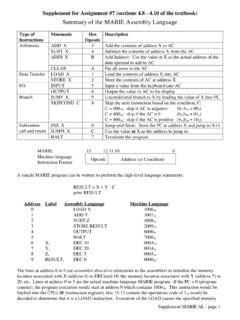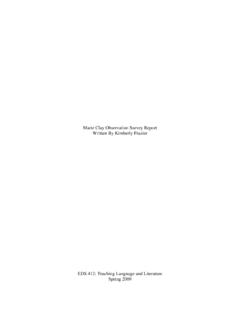Transcription of How to Take Running Running Records are taken to: Records
1 How to Take RunningRecords(adapted from Alphakids Assessment Kit Teacher s Guide) Running Records capture what children know and understand aboutthe reading process. They capture children s thinking. Running Recordsprovide you with an opportunity to analyze what happened and planappropriate instruction. From Running Records , you have evidence ofwhat the child is able to do, ready to learn, and learning over a periodof time. Noted researcher Marie Clay designed this very effective andwidely used Running record is not just the recording of right and wrong requires observing all behaviours to help determine the thinkingprocess children are using as they read the text.
2 A correct responsedoes not necessarily reveal the thinking a child is using unless they haveverbalized or shown through body language ( , eyes go to thepicture, finger moves back across the text) their mental processing. ARunning record provides you with a playback of an entire oral readingconference, including the smallest details on the reader s attitude,demeanour, accuracy, and this information, youcan analyze behaviours, responses, competencies, initiatives taken , andin turn, determine instructional needs. You are therefore encouraged torecord all behaviours children display during reading Records are also a critical piece of assessment for theformation of dynamic (changing regularly) guided reading groups, andallow for the selection of just right texts and the teaching ofappropriate strategies.
3 Running Records allow you to documentprogress over time when an initial or baseline record is compared to amore recent a Running RecordTo take a Running record , sit beside a child as he or she reads a selected portion of the text aloud in a natural and relaxed environment. It is necessary to select a time when you can hear the child read without interruptions, such as when children are engaged in quiet reading or on independent literacy activities. Observe and record everything the child says and does during the reading. You will find yourself noticing more and more about children s reading behaviours each time you take a Running record .
4 Because there is a set code for recording, all teachers can understand and then discuss, analyze, and plan teaching strategies for the child or small groups of following conventions provide a consistent approach to recordingreading behaviours. (Based on Clay 1993, Kemp 1987, and Goodman &Burke 1972) With these notations, every effort the child makes isrecorded in detail. For a readily available recording sheet, see page Records aretaken to: guide teaching match readers to appropriate texts document growth overtime note strategies used group and regroup children for instruction Behaviour Notation Example*An appeal for help from the child is turned back to the child for further effort ( , Say: You try it.)
5 If the child is unsuccessful, the word is teacher-given (told word). Correct response Mark every word read correctly with a check mark. Can you see my eyes? Substitution Write the spoken word above the word the in the text. Can you see my eyes? Omission Place a dash above the word left out. Can you see my eyes? Insertion Insert the added word and place a dash big below it (or use a caret). Can you see my eyes? Attempt Write each attempt above the word e-ey in the text.
6 Can you see my eyes? Repetition Write R after the repeated word/phrase and draw an arrow back to the R beginning of the repetition. Can you see my eyes? Appeal* Write A above the appealed word. A (asks for help) Can you see my eyes? Told word Write T beside the word supplied for the reader. Can you see my T eyes? Self-correction Write SC after the corrected word. the/SC Can you see my eyes?Scoring a Running RecordYou can use the following scoring to assess a child s Count only the Running words in a text.
7 Running words do not include titles, subtitles, captions, and so on. 2. 3. Count each word in a skipped line as an add errors. A reader could have more errors than there are words on a , a reader cannot have more errors than wordson a page. Count as one error: Do not count: a substitution self-corrections an omission repetitions an incorrect attempt a correct attempt an unsuccessful appeal a successful appeal a told word words pronounced differently in a child s dialect or accent an insertion4. Count a skipped page as one error and subtract the word count for that page from the total word Count proper nouns read inaccurately only once.
8 Count other words read inaccurately each Calculate the Percent of Accuracy for a record by subtracting the total number of errors made from the number of Running words in the text. The answer will then be divided by the number of Running Determine the Self-Correction Rate for a record . The Self-Correction Rate indicates how well a child self-monitors his or her reading. Calculate this rate by adding the total number of errors to the total number of self-corrections and dividing this sum total by the total number of self-corrections. For example, six total errors plus two self-corrections equals eight.
9 If you divide eight by the total number of self-corrections, the answer is four. The self-correction rate is then recorded as 1:4, which shows the child self-corrected one time for every four words misread. A Self-Correction Rate of up to 1:5 shows the child is self-monitoring and using decoding Once you have calculated the Percent of Accuracy and the Self-Correction Rate, you can determine whether the reading level for that book is easy, instructional, or hard for for a particular Self-Correction Rate1. Total Errors + Total Self-Corrections = Sum Total2.
10 Sum Total Total Self-Corrections = Rate= =1:Calculating Percent of Accuracy1. Running Words Total Errors = Score2. Score Running Words 100 = % Accuracy 100 = =% Understanding PercentagesEasy Texts (96-100%)When children read an easy text, they are able to read for enjoyment and meaning. There are no decoding challenges. Easy texts are appropriate for independent Instructional Texts (93-95%)These texts are selected by you, and have many supports and very few challenges for the reader. They are at the higher-end of what Clay has identified as Instructional Texts (90-95%).


